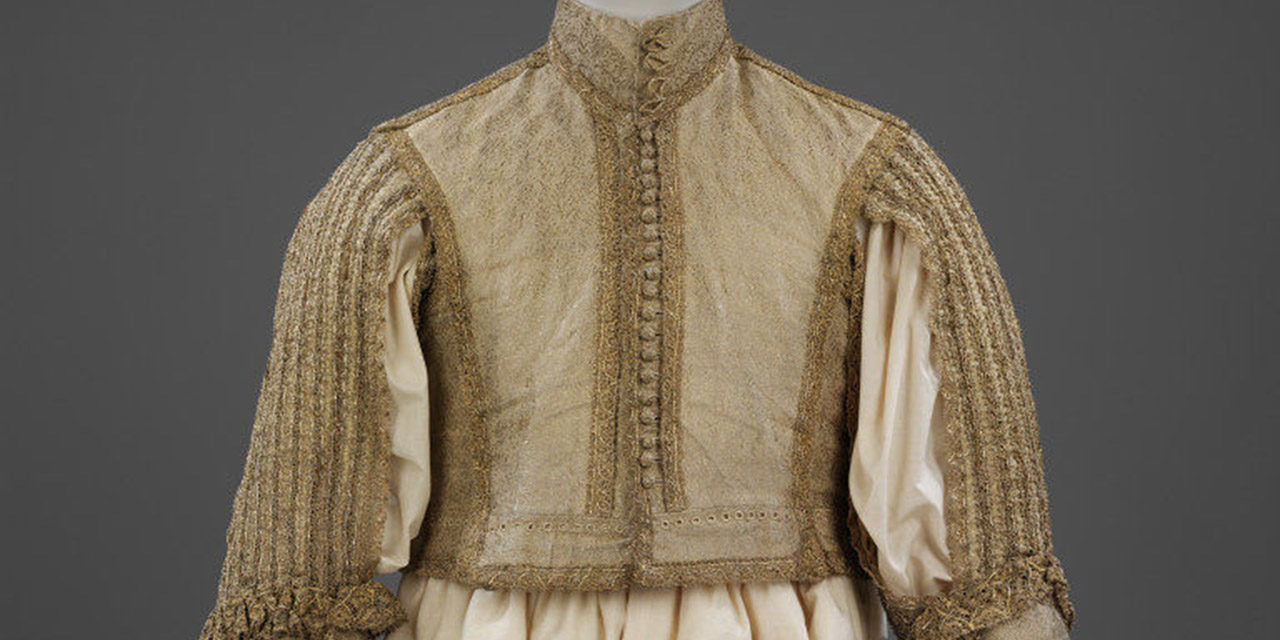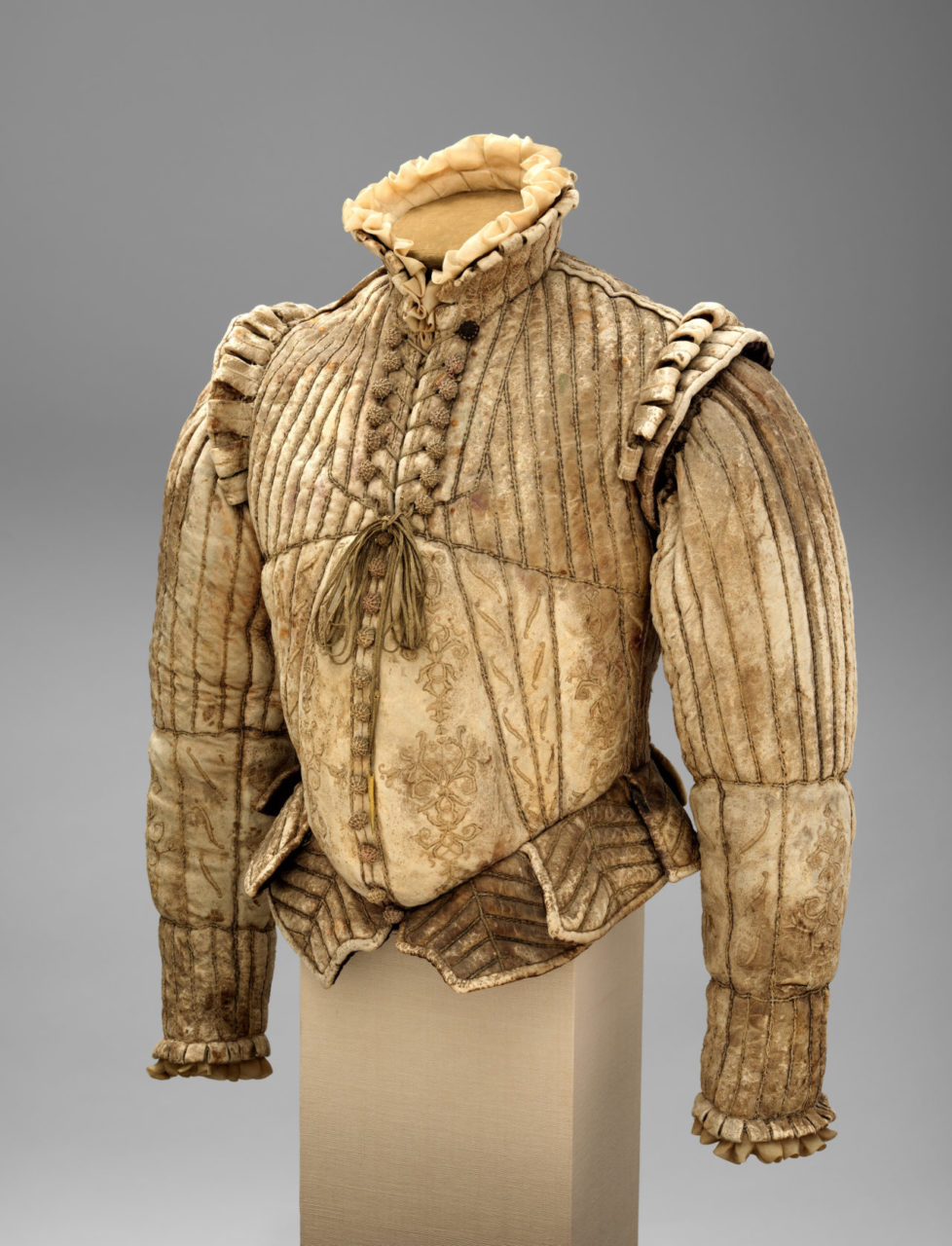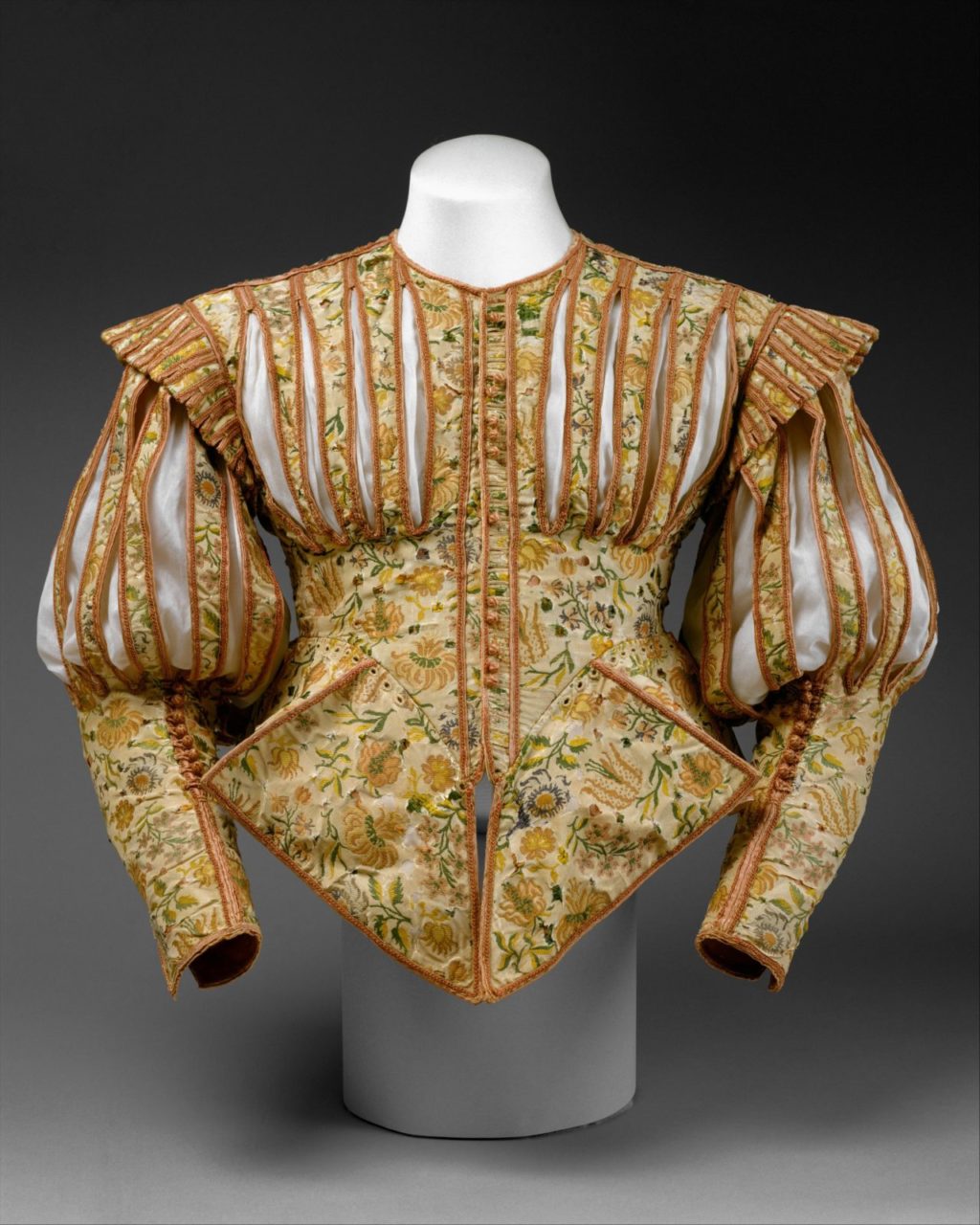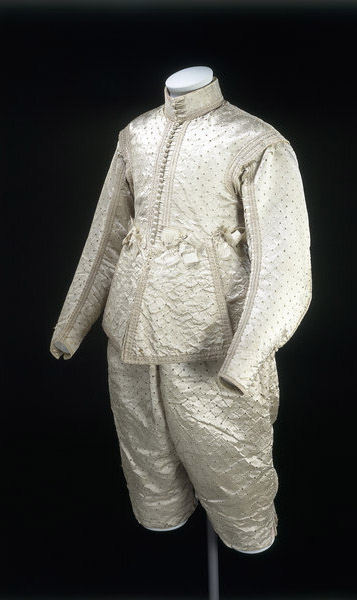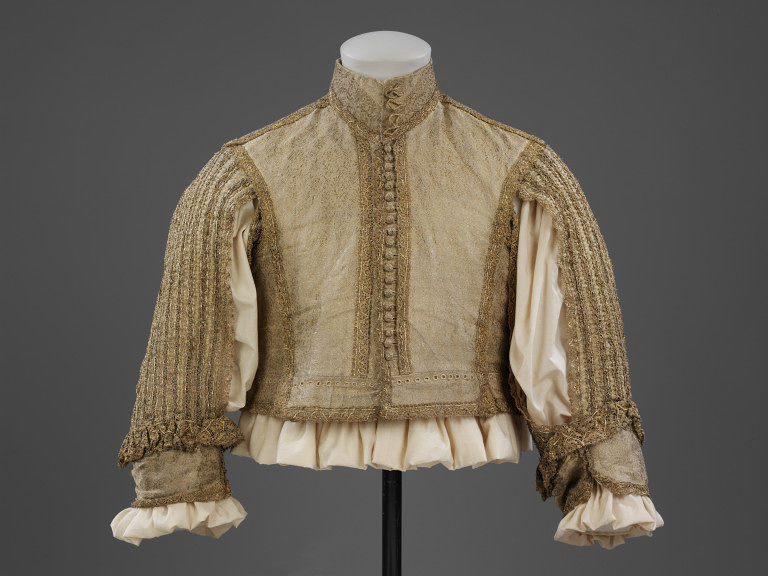An often snug-fitting jacket that is shaped and fitted to a man’s body–worn mostly in the 15th to 17th centuries.
The Details
A
ccording to Karen Baclawski in The Guide to Historic Costume (1995), a doublet is:
“an outer garment for the upper body worn over a shirt, the doublet was worn by men from the fourteenth century to c. 1670. Doublets were long-sleeved, often had standing neckbands and fastened at the centre front usually by means of lacing or buttons. Early doublets were close fitting garments tailored to set off a man’s physique; they nipped in at the waist and had short skirts below. They also provided the means of keeping up the hose, and later the breeches, worn with the doublet.” (90)
An example of just such a long-sleeved doublet with a standing neckband and center front fastening is in the Met’s collection (Fig. 1). The Berg Dictionary of Fashion History describes the varying forms of the doublet over the centuries:
“The term ‘doublet’, though used in France in the 14th century, was not general in England for civilian wear until the 15th century. It was a padded jacket worn next to the shirt; close-fitting and waisted but not usually belted unless worn without an over-garment. Doublet skirts varied from non-existent or very narrow to covering the hips, according to changing fashions. In the 17th century the skirts consisted of a series of tabs of varying depth. In the late 15th and early 16th centuries the front was widely open, requiring a stomacher or partlet fill-in. The 14th-century dancing doublet was often heavily embroidered.”
Dion Calthrop in English Costume’s (1906) definition of the doublet pertains to the late 16th century to the early 17th century version. He states:
“For the shapes, the doublet was a close-fitting garment, cut, if in the Italian fashion, down to a long peak in front. They were made without sleeves, like a waist coat, and an epaulette overhung the armhole.” (74)
Figure 2 is just such a sleeveless doublet (Fig. 2). Willet and Phillis Cunnington’s Handbook of English Costume in the Seventeenth Century (1972) describes doublet styles of the first half of the 17th century, noting that first style consisted of a body that was:
“close-fitting, long waisted, often busked with whale bone, and the front lining stiffened with buckram, canvas or thick material was usually with belly pieces…the doublet was lined and often quilted throughout… the waistline was low [and] was studded all around with pairs of eyelet holes bound with thread… for the attachment of breeches…A high standing collar sometimes sloping to a V under the chin.” (13)
The Met has a 1620s doublet in their collection with some of those features (Fig. 3). The Victoria & Albert Museum has a good example of the second style described (Fig. 4):
“Easy fitting and high waisted. The corset shape was discarded. No padding and very little stiffening, except for the belly pieces…Eyelet holes were absent…the neck had a high-standing collar…[the] sleeves [were] moderately loose…[or] full to the elbow and paned, and thence closed to the wrist.” (16)
And the final style was the “Skimpy Doublet.” This doublet “… was short, not padded but lined and often stiffened in front with belly pieces” (16). The V&A has just such a skimpy doublet in its collection (Fig. 5), of which it writes:
“Doublets formed part of the fashionable ensemble of clothing worn by men in Europe until the late 1660s. The very short length of this example is characteristic of the extreme style of doublets at their final appearance in the male wardrobe. From 1650 to 1665, doublets shortened so that there was a gap between doublet and breeches through which the shirt could be seen. The centre back and front sleeves were left unstitched for further exposure of the shirt, which in the 17th century was considered underwear. More conservative members of society considered the result rather untidy looking. Such a radical fashion, usually worn by young men, attracted the attention of cartoonists and the condemnation of moralists.”
Fig. 1 - Maker unknown (Western European). Fencing Doublet, ca. 1580. Leather, silk, linen, cotton. New York: The Metropolitan Museum of Art, 29.158.175. Bashford Dean Memorial Collection, Funds from various donors, 1929. Source: The Met
Fig. 2 - Maker unknown (European). Doublet, ca. 1580. Silk, metallic thread, brass. New York: The Metropolitan Museum of Art, 1978.128. Catherine Breyer Van Bomel Foundation Fund, 1978. Source: The Met
Fig. 3 - Maker unknown (French). Doublet, early 1620s. Silk. New York: The Metropolitan Museum of Art, 1989.196. The Costume Institute Fund, in memory of Polaire Weissman, 1989. Source: The Met
Fig. 4 - Maker unknown (English). Doublet, 1630-1640. Satin, stamped, lined with linen and buckram, trimmed with braid and silk ribbon, hand-sewn. London: Victoria & Albert Museum, 348&A-1905. Source: V&A
Fig. 5 - Maker unknown (British). Doublet, 1650-1665. Silver-gilt silk tissue, trimmed with silver-gilt bobbin lace, lined with silk taffeta and reinforced with linen, hand-sewn with silk and linen thread. London: Victoria & Albert Museum, T.91-2003. Purchased with Art Fund support and assistance from the Friends of the V&A, and a number of private donors. Source: V&A
References:
- Baclawski, Karen. The Guide to Historic Costume. New York: Drama Book Publishers, 1995. http://www.worldcat.org/oclc/60155138.
- Calthrop, Dion Clayton. English Costume. London: Adam and Charles Black, 1926. http://www.worldcat.org/oclc/1015320606.
- Cumming, Valerie, C. Willett Cunnington, Phillis Cunnington, Charles Relly Beard, and C. Willett Cunnington. “Doublet.” In The Dictionary of Fashion History. Oxford: Berg, 2010. http://www.worldcat.org/oclc/1008259246.
- Cunnington, C. Willett, and Phillis Emily Cunnington. Handbook of English Costume in the Seventeenth Century. Boston: Plays, Inc, 1972. http://www.worldcat.org/oclc/755269282.
- “Doublet | V&A Search the Collections.” V and A Collections, August 15, 2018. http://collections.vam.ac.uk/item/O85964.

